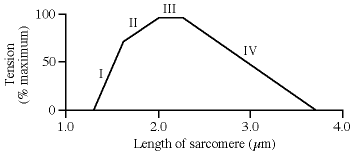- Joined
- Jan 16, 2009
- Messages
- 293
- Reaction score
- 0
Look at the four labeled regions of the curve below, which represents the four steps of the muscle contraction cycle according to the sliding-filament model. Consider only those regions where the actin thin filaments of the sarcomere overlap each other to some degree. In which region is there the LEAST amount of overlap of the actin thin filaments with each other?

A. I
B. II
C. III
D. IV
How do you do this?
2. Are they expecting us to know that cyanogen bromide cuts after methionine in this question or am I missing something? (youd have to have the test to look at this)
Q: The fragmentation caused by cyanogen bromide in Experiment I, plus the binding of cysteine by dabsyl chloride in Experiment II, tell you that the EXACT sequence of the polypeptide is known up to which amino acid? From passage 2
3. If arsenate (HOAsO32-) were substituted for inorganic phosphate (Pi) in Step 6 of glycolysis, the net production of ATP from the glycolytic pathway in active skeletal muscle would be:
A. 0
B. 2
I picked 0 just because I thought the process wouldnt work anymore. I dont understand the explanation they give for this, was my reasoning valid or should I look at other things?
4. During anaerobic glycolysis in an active muscle, the net change in oxidation state that occurs when one molecule of glucose is converted into two molecules of lactic acid is:
A. -4
B. -2
C. 0
D. +2
If pyruvate get reduced to lactate (from passage), then how can the answer be 0?
5. In exercising muscles, where the oxygen concentration is low, the rate of glycolysis increases because of an increase in the cytosolic concentrations of:
A. ADP
B. NAD+
Why is the answer not NAD+
6. To convert lidocaine into 3-hydroxylidocaine, what must be added to it?
http://upload.wikimedia.org/wikipedia/commons/5/55/Lidocaine_Structure.png

How do u know which C theyre yalking about?
7. What is the net charge on vasopressin, if it is being eliminated in urine that has a maximum alkaline pH of 8.0?
From passage: The N-terminus has a pKa of about 8.0, the phenolic hydroxyl has a pKa of about 10.0, and the guanidino group has a pKa of about 12.5.
How do you do this?

A. I
B. II
C. III
D. IV
How do you do this?
2. Are they expecting us to know that cyanogen bromide cuts after methionine in this question or am I missing something? (youd have to have the test to look at this)
Q: The fragmentation caused by cyanogen bromide in Experiment I, plus the binding of cysteine by dabsyl chloride in Experiment II, tell you that the EXACT sequence of the polypeptide is known up to which amino acid? From passage 2
3. If arsenate (HOAsO32-) were substituted for inorganic phosphate (Pi) in Step 6 of glycolysis, the net production of ATP from the glycolytic pathway in active skeletal muscle would be:
A. 0
B. 2
I picked 0 just because I thought the process wouldnt work anymore. I dont understand the explanation they give for this, was my reasoning valid or should I look at other things?
4. During anaerobic glycolysis in an active muscle, the net change in oxidation state that occurs when one molecule of glucose is converted into two molecules of lactic acid is:
A. -4
B. -2
C. 0
D. +2
If pyruvate get reduced to lactate (from passage), then how can the answer be 0?
5. In exercising muscles, where the oxygen concentration is low, the rate of glycolysis increases because of an increase in the cytosolic concentrations of:
A. ADP
B. NAD+
Why is the answer not NAD+
6. To convert lidocaine into 3-hydroxylidocaine, what must be added to it?
http://upload.wikimedia.org/wikipedia/commons/5/55/Lidocaine_Structure.png

How do u know which C theyre yalking about?
7. What is the net charge on vasopressin, if it is being eliminated in urine that has a maximum alkaline pH of 8.0?
From passage: The N-terminus has a pKa of about 8.0, the phenolic hydroxyl has a pKa of about 10.0, and the guanidino group has a pKa of about 12.5.
How do you do this?
